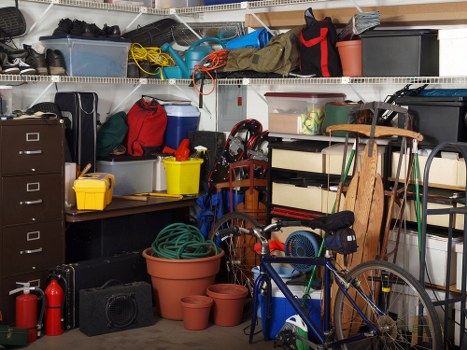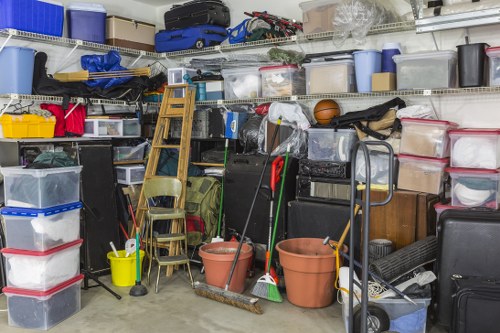Efficient Demolition Waste Removal in Staines
Understanding Demolition Waste

Demolition waste refers to the debris generated from the dismantling of buildings, structures, and other constructions. In Staines, a town bustling with development and renovation projects, managing this waste efficiently is crucial for maintaining cleanliness and environmental standards.
Proper demolition waste removal not only ensures the aesthetic appeal of the area but also promotes sustainability by recycling and reusing materials whenever possible.
Failure to manage demolition waste effectively can lead to environmental pollution, health hazards, and unnecessary strain on local disposal facilities.
Why Choose Professional Services?

Opting for professional demolition waste removal services in Staines guarantees that the process adheres to local regulations and environmental guidelines. Experienced companies have the necessary equipment and expertise to handle various types of demolition debris safely and efficiently.
Professional services also offer timely removal, preventing the accumulation of waste that can impede ongoing projects and disrupt the local community.
Additionally, experts can provide valuable advice on recycling opportunities and material separation, contributing to a more sustainable approach.
Types of Demolition Waste

Understanding the different categories of demolition waste is essential for effective removal and recycling. Common types include:
- Concrete and Masonry: Often recycled into aggregate for new construction projects.
- Wood: Can be repurposed or processed into biomass for energy production.
- Metals: Recycled to reduce the need for new metal extraction.
- Plastics and Insulation: Handled carefully to prevent environmental contamination.
- Hazardous Materials: Requires specialized handling and disposal to ensure safety.
Proper categorization facilitates efficient recycling processes and minimizes the amount of waste sent to landfills.
Steps Involved in Demolition Waste Removal

The demolition waste removal process typically involves several key steps:
- Assessment: Evaluating the site and the types of waste generated.
- Segregation: Separating recyclable materials from non-recyclable waste.
- Transportation: Moving the waste to appropriate recycling facilities or disposal sites.
- Recycling and Disposal: Processing the materials to minimize environmental impact.
- Documentation: Maintaining records to comply with local regulations.
Each step requires meticulous planning and execution to ensure effectiveness and compliance.
Benefits of Proper Waste Removal

Implementing a structured approach to demolition waste removal offers numerous advantages:
- Environmental Protection: Reduces pollution and conserves natural resources through recycling.
- Cost Efficiency: Minimizes disposal fees and can generate revenue from recyclable materials.
- Regulatory Compliance: Ensures adherence to local laws, avoiding fines and legal issues.
- Community Health: Prevents health hazards associated with unmanaged waste.
- Enhanced Aesthetics: Maintains a clean and appealing environment.
These benefits collectively contribute to sustainable development and improved quality of life in Staines.
Choosing the Right Removal Partner
Experience and Expertise
Select a company with a proven track record in demolition waste removal. Experienced professionals understand the complexities involved and can navigate challenges effectively.
Comprehensive Services
Opt for providers that offer a full range of services, from initial assessment to final disposal. This ensures a seamless process and reduces the need for multiple contractors.
Environmental Commitment
Choose companies dedicated to sustainable practices. They should prioritize recycling and responsible disposal to minimize environmental impact.
Transparent Pricing
Transparent and competitive pricing structures help you budget effectively without unexpected costs.
Customer Support
Reliable customer support ensures that your queries and concerns are addressed promptly throughout the process.
Regulations and Compliance in Staines
[h3]Legal Requirements[/h3]Adhering to local regulations is essential for demolition waste removal. Staines has specific guidelines that govern how waste should be handled, transported, and disposed of.
Non-compliance can result in hefty fines and project delays, making it imperative to work with knowledgeable removal services.
Permits and Documentation
Obtaining the necessary permits and maintaining proper documentation ensures that all activities are conducted legally and transparently.
Environmental Standards
Staines enforces strict environmental standards to protect its natural surroundings. Ensure that waste removal practices align with these standards to support community sustainability efforts.
Recycling and Sustainability
Recycling Facilities
Staines boasts several recycling facilities equipped to handle various types of demolition waste. Utilizing these facilities reduces the environmental footprint of your projects.
Resource Recovery
Recovering valuable materials from demolition waste not only conserves resources but also supports the local economy by creating recycling jobs.
Green Building Practices
Incorporating green building practices involves using recycled materials in new constructions, fostering a sustainable development cycle.
Community Initiatives
Engaging in community recycling programs and initiatives promotes collective responsibility towards waste management and environmental preservation.
Future Trends
The future of demolition waste removal lies in advanced recycling technologies and innovative practices that further minimize waste and maximize resource efficiency.
Cost Factors in Demolition Waste Removal
Volume of Waste
The amount of waste generated directly influences the cost. Larger projects typically incur higher removal fees due to the increased resources required.
Type of Materials
Certain materials, especially hazardous or non-recyclable ones, may cost more to remove and dispose of properly.
Transportation Logistics
Distance to disposal or recycling facilities and the complexity of transporting heavy or bulky materials can affect overall costs.
Permit Fees
Obtaining necessary permits involves fees that contribute to the total cost of waste removal.
Service Levels
Premium services, such as expedited removal or additional labor, will typically incur higher charges.
Preparing for Demolition Waste Removal
Site Assessment
Conduct a thorough assessment of the demolition site to identify the types and quantities of waste present.
Sorting and Segregation
Pre-sorting materials can streamline the removal process and enhance recycling opportunities.
Safety Measures
Implementing safety protocols ensures the protection of workers and the community during the removal process.
Scheduling
Coordinating removal activities with project timelines helps prevent delays and ensures efficient waste management.
Communication
Clear communication with the removal service provider ensures that all expectations and requirements are met.
Case Studies: Successful Waste Removal in Staines
Residential Demolition
A local family successfully renovated their home by partnering with a professional demolition waste removal service, ensuring that materials were recycled and the site remained clean.
Commercial Projects
A commercial developer reduced project costs by effectively managing demolition waste, using recyclables to offset expenses and adhering to environmental regulations.
Public Infrastructure
Staines' public infrastructure projects have benefited from efficient waste removal, maintaining community standards and promoting sustainability.
Challenges in Demolition Waste Removal
Hazardous Materials
Handling hazardous materials like asbestos requires specialized procedures and equipment, presenting significant challenges.
Logistical Constraints
Limited access to disposal sites and congestion in transportation can hinder timely waste removal.
Recycling Limitations
Not all materials can be recycled, necessitating effective disposal methods for non-recyclable waste.
Cost Management
Balancing cost with effective waste removal strategies is a constant challenge for project managers.
Regulatory Compliance
Staying updated with evolving regulations requires continuous effort and adaptation.
Innovations in Waste Removal
Advanced Sorting Technologies
Innovative sorting systems enhance the efficiency of material separation, increasing recycling rates.
Automated Machinery
Automation in waste removal processes reduces labor costs and minimizes human error.
Green Logistics
Eco-friendly transportation methods lower the carbon footprint associated with waste removal.
Digital Tracking
Using digital tools for tracking waste ensures transparency and improves management efficiency.
Circular Economy Models
Adopting circular economy principles promotes the continual use of materials, reducing overall waste.
Choosing the Right Disposal Method
Landfill Disposal
While common, landfill disposal should be minimized due to its environmental impact.
Recycling Centers
Recycling centers in Staines provide facilities to handle various materials, promoting sustainability.
Incineration
For non-recyclable materials, incineration offers a method of reducing waste volume.
Composting
Organic demolition waste can be composted, enriching soil and supporting green landscapes.
Hazardous Waste Treatment
Specialized treatment processes ensure that hazardous materials are neutralized and safely disposed of.
Environmental Impact of Waste Removal
Reducing Carbon Footprint
Effective waste removal can lower the carbon footprint by promoting recycling and reducing transportation needs.
Conserving Natural Resources
Recycling materials conserves natural resources, reducing the need for raw material extraction.
Promoting Biodiversity
Proper waste management supports local ecosystems by preventing pollution and habitat destruction.
Climate Change Mitigation
Minimizing waste contributes to climate change mitigation efforts by reducing greenhouse gas emissions.
Sustainable Development
Integrating waste removal into sustainable development plans ensures long-term environmental health.
Future of Demolition Waste Removal in Staines
Technological Advancements
Emerging technologies will continue to revolutionize waste removal, making it more efficient and eco-friendly.
Increased Recycling Rates
Future initiatives aim to increase recycling rates, aiming for higher sustainability benchmarks.
Policy Developments
Anticipate stricter regulations and policies that will drive more responsible waste management practices.
Community Engagement
Greater community involvement and awareness will play a pivotal role in successful waste removal strategies.
Integration with Smart Cities
Waste removal systems will integrate with smart city infrastructures, enhancing coordination and efficiency.
Conclusion

Effective demolition waste removal in Staines is essential for fostering a clean, sustainable, and healthy community. By partnering with professional services, adhering to regulations, and embracing recycling and innovative practices, residents and businesses can significantly reduce their environmental impact.
Investing in proper waste management not only benefits the local ecosystem but also enhances the overall quality of life in Staines. Don’t let demolition debris hinder your projects—contact us today to ensure efficient and responsible waste removal.
Embrace sustainability and make informed choices for a better tomorrow. Book your service now and contribute to a greener Staines.